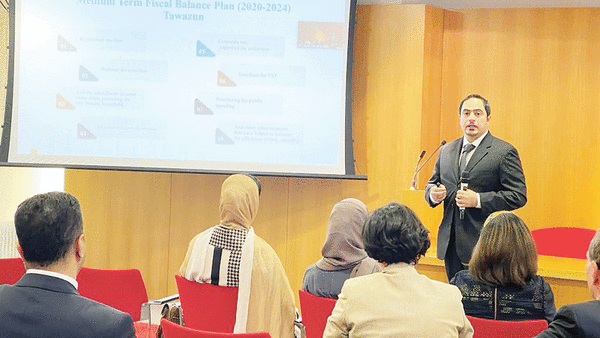

MUSCAT, APRIL 29
The Omani economy is poised for a recovery, buoyed by massive projects, diversification of income sources, and optimal utilisation of financial resources, according to Dr Khalid bin Said al Amri (pictured), Chairman of the Board of Directors of the Omani Economic Society.
Speaking at a lecture organised by the British-Omani Society in London, Dr Al Amri praised the wise leadership of His Majesty Sultan Haitham bin Tarik and the government’s financial plans and programmes, which he believes will help Oman recover in the coming period.
Dr Al Amri also discussed the laws and regulations that will support economic aspects, such as the expected Labour Law, Social Protection Law, and Public Debt Law in 2023.
He predicts that Oman’s credit rating will continue to improve in the coming years with the implementation of financial measures and policies aimed at achieving financial sustainability and regulating public finances.
Despite going through a tough period due to the Covid-19 crisis and the collapse of oil prices, the Omani economy has recovered thanks to the government’s economic reforms, initiatives, and programmes.
Oman is expected to continue working on improving the business environment, providing financing sources with competitive interest rates for various projects, and attracting foreign investment.
The country will also focus on economic diversification plans and developing governorates by granting them more authority, developing economic leadership, activating the role of civil society institutions and regulatory authorities, as well as utilising the surplus in the budget to create export-oriented economic projects that generate jobs, and focusing on education and its quality.
Green hydrogen
Oman will also be an important global centre for the production and export of green hydrogen, with five giant projects expected in the sector.
These include the ‘Duqm Hyperscale Green Hydrogen Project’, the Oman Hydrogen Project, the JEA Green Energy Project, the H2Oman Project, and the Salalah H2 Project.
The Chairman of the Oman Economic Society highlighted the most important financial and economic developments in Oman from February 2020 to March 2023, which included the launch of the National Financial Sustainability Programme and Financial Sector Development to enable the growth of the economy and increase investments, ensuring sustainability and financial stability. His Majesty Sultan Haitham bin Tarik, the economist noted, has extended job security benefits for former employees working for Omani citizens until the end of June 2023 to maintain social and economic stability.
His Majesty has also directed an increase in the financial allocations for the 2022 development budget to RO 1.1 billion, while the Council of Ministers has approved the reduction, cancellation, and merging of 288 fees to support economic activities, enhance national economy competitiveness and facilitate government procedures.
The Tenth Five-Year Plan (2021-2025) will feature several new development projects worth over RO 52 million, including the dualisation of Sultan Qaboos Street in Salalah, rehabilitation and construction of the rainwater drainage system in Sultan Qaboos Street in Salalah, and the implementation of a multipurpose port project in the Wilayat of Masirah.
Other projects include the construction of three hospitals, establishment of 76 government schools, completion of compensations related to the coastal interior road, establishment of a new airport in Khasab, execution of the Dibba-Lima-Khasab road and connecting it to Khamis Mushayt in the Governorate of Musandam, among others.
Monetary and economic indicators show that the Gross Domestic Product (GDP) is expected to reach RO 44.1 billion by the end of 2022, a 30 per cent increase from the previous year.
Foreign currency reserves of the Central Bank of Oman rose to $16.6 billion by the end of June 2022.
Traditional commercial banks’ total deposits increased to RO 26.3 billion, a 5.5 per cent increase, and the total credit balance provided by local banks increased by 3.9 per cent to RO 28.8 billion by the end of September 2022, Dr Al Amri stated.
The Financial Balance Plan aims to reduce public debt as a percentage of GDP from 69.7 per cent in 2020 to 46.5 per cent in 2022 by reducing external borrowing, repurchasing sovereign bonds, paying off high-cost loans, and issuing local bonds for trading on the Muscat Stock Exchange at a relatively low cost.
The plan was developed due to the sharp and sudden drop in oil prices, which remained low for an extended period, and the public spending’s inability to adapt to the situation, he added.
Oman Observer is now on the WhatsApp channel. Click here



